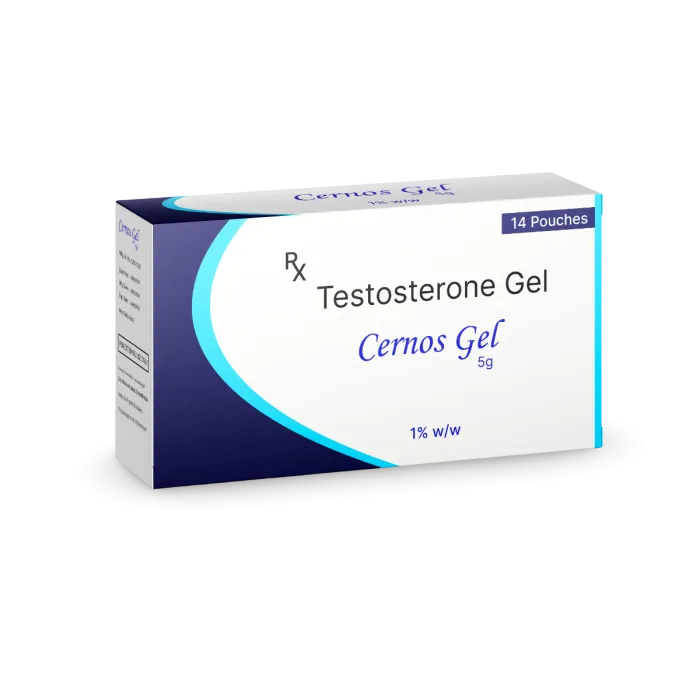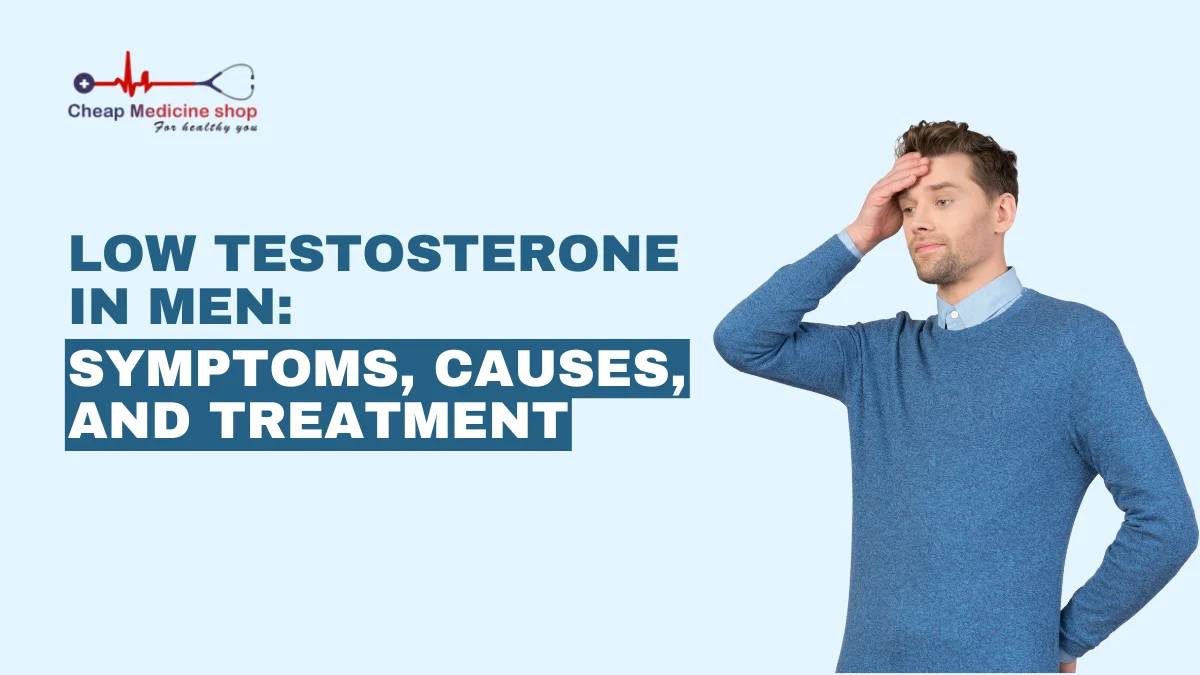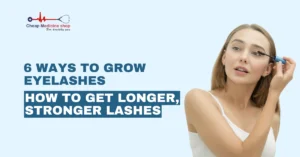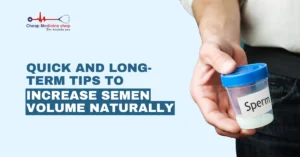Testosterone is essential for developing male sexual characteristics, muscle mass, bone density, and overall well-being. Naturally, Testosterone levels change throughout the day, from being higher in the morning to gradually declining at night.
Similarly, it also changes as a man ages. While Testosterone levels significantly decline with age, some men experience a significant drop. It leads to a medical condition called male Hypogonadism or Low Testosterone. The condition not only affects a man’s sexual characteristics but also disrupts the body’s vital processes.
Therefore, learning about its signs and causes is essential to diagnose this condition early and seek immediate treatment.
This article elaborates on Low Testosterone, its symptoms, causes, diagnosis, and treatment in detail.
What is Low Testosterone in men?
Low Testosterone levels, or Low T, is a condition where your body produces insufficient Testosterone. Low Testosterone levels are also known by the following names:
- Testosterone deficiency
- Primary Hypogonadism
- Hypergonadotropic Hypogonadism
Generally, a Testosterone level less than 300 nanograms per deciliter (ng/dL) is considered low and can indicate male Hypogonadism. However, some clinicians may consider levels below 250 ng/dL low, and clinical judgment is also important in assessing symptoms.
Save up to 90% on your medicine bills

Cernos Gel 1%w/w

Cernos 40 Mg Soft Gelatin Capsule

Sustanon 250 Injection

Carmel Organics Ashwagandha Extract Tablets
Normal Testosterone levels by age
The table below briefly depicts the normal levels of Testosterone in men with age:
| Age | Normal Testosterone levels (ng/dL) |
|---|---|
| Below 1 year | Less than 12 |
| 1-5 years | Less than 12 |
| 6-10 years | Less than 25 |
| 11-15 years | Less than 830 |
| 16-17 years | 102 to 1010 |
| 18-99 years | 193 to 824 |
Signs of Low Testosterone in men
Low Testosterone can lead to various physical, sexual, and psychological symptoms. While not every man will experience all symptoms, some common Low Testosterone symptoms in men are as follows:
Physical symptoms
Some common physical signs of Low Testosterone are as follows:
- Reduced muscle mass and strength
- Increased body fat
- Decreased bone density (Osteoporosis)
- Loss of body and facial hair
- Enlarged breasts (Gynecomastia)
- Smaller testicle and penis size
- Hot flashes and night sweats
- Fatigue and low energy
Sexual symptoms
Certain sexual signs of Testosterone deficiency are as follows:
- Reduced sex drive (libido)
- Difficulty achieving or maintaining erections
- Fewer spontaneous erections
- Infertility due to low sperm production
- Decreased frequency of sexual activity
Psychological symptoms
Several psychological symptoms of Testosterone deficiency are as follows:
- Depression or low mood
- Irritability or increased anger
- Anxiety
- Difficulty concentrating
- Decreased motivation or drive
- Sleep disturbance
Symptoms of Low Testosterone in children
Certain symptoms of Low Testosterone in children are as follows:
- Shunted growth with arms and legs growing out of proportion
- Low strength and endurance
- Less deepening of voice
- Fewer sexual characteristics
- Reduced pubic hair development
What causes Low Testosterone in men?
Low Testosterone can result from various factors, broadly classified into primary and secondary Hypogonadism. Some common causes of Low Testosterone in men are as follows:
Primary Hypogonadism
This originates from a problem in the testicles, which leads to inadequate Testosterone production. The common causes of Hypogonadism include:
- Klinefelter Syndrome: It is a genetic disorder where males have an extra X chromosome.
- Undescended testicles: In this condition, testicles do not descend into the scrotum before birth.
- Mumps Orchitis: It causes inflammation of the testicles due to a mumps infection.
- Hemochromatosis: Excess iron in the blood damages the testicles.
- Physical injury: Trauma to both testicles can also lead to inadequate Testosterone production.
- Cancer treatments: Chemotherapy or radiation therapy can impair testicular function, leading to Low Testosterone in males.
Secondary Hypogonadism
This type is due to problems in the hypothalamus or pituitary gland, which regulate Testosterone production. Some common causes include:
- Pituitary disorders: Tumors or other diseases affecting hormone production.
- Inflammatory diseases: Certain inflammatory diseases, such as Sarcoidosis or Tuberculosis.
- HIV/AIDS: This type of Sexually Transmitted Disease (STD) can affect the hypothalamus, pituitary, or testicles.
- Medications: Opiate pain medications, Corticosteroids, and some hormones can disrupt Testosterone production in men.
- Obesity: Excess body fat can disrupt hormone balance and lead to low levels of Testosterone.
Diagnosis of Low Testosterone in men
Depending on the underlying cause of low levels of Testosterone, your doctor will determine if you have Low Testosterone levels with the help of the following tests:
- Medical history and physical examination: Your doctor assesses symptoms, medical history, and certain risk factors associated with reduced Testosterone levels.
- Blood tests: Your doctor can include a blood test to measure total Testosterone levels, usually in the morning when levels are highest.
- Additional testing: Your doctor can perform other tests to identify the underlying causes (such as pituitary or testicular disorders) and check other hormone levels, such as Luteinizing Hormone (LH) and Follicle-stimulating Hormone (FSH).
It is important to note that some men may have low blood Testosterone but no symptoms, while others may have symptoms with borderline levels. A diagnosis is typically made when both low levels and symptoms are present.
Low Testosterone treatment in men
After a complete diagnosis of your condition, your doctor can prescribe you the Low Testosterone treatment. The most common treatment for hormone deficiency in men is Testosterone Replacement Therapy (TRT). Some different forms of TRT are as follows:
Testosterone patch
You apply these transdermal patches on the skin, usually on the arm or upper body. These are replaced every 24 hours. The patch delivers a consistent dose of Testosterone throughout the day. Application sites should be rotated, and the same spot should not be used again for at least seven days to minimize skin irritation or rash.
Intramuscular Testosterone injections
Intramuscular injections, such as Testenate Depot 250 Injection, involve injecting Testosterone Esters (a long-acting form of Testosterone) into a muscle. These are usually administered every one to four weeks. This method produces a rapid rise in Testosterone levels followed by a gradual decline, which can lead to fluctuations in mood or energy.
Testosterone skin gel
Testosterone skin gel for men is a clear gel applied once daily to clean skin. It is usually applied to the shoulders, upper arms, or thighs. The hormone is absorbed through the skin, providing steady Testosterone levels.
You must let the gel dry before dressing and avoid accidental transfer to others. It is because the contact with the application site or unwashed clothing can expose children or women to Testosterone.
Testosterone pellets
Testosterone pellets are small implants placed under the skin during a minor office procedure. They release Testosterone gradually over three to six months, offering long-lasting and stable hormone levels.
Pellets are convenient for those who prefer less frequent dosing options but require a minor surgical procedure for insertion.
Testosterone nasal gel
Testosterone nasal gel is used inside the nostrils, usually thrice daily. The gel is absorbed through the nasal lining, providing a rapid onset of action. This form avoids skin and injection site issues but requires frequent daily dosing and may cause nasal irritation. Users should avoid blowing their nose or sniffing for at least an hour after application.
Buccal Testosterone tablets
Buccal Testosterone tablets are small patches that adhere to the upper gum, releasing Testosterone through the oral mucosa (the membrane that lines the inside of the mouth). They are replaced every 12 hours and provide steady hormone delivery without skin or injection site reactions. Some users may experience gum or mouth irritation and taste changes.
Oral Testosterone pills
Oral Testosterone pills (such as Testosterone Undecanoate capsules) are taken by mouth, usually with food, to enhance absorption. Newer oral forms are absorbed via the lymphatic system, reducing the risk of liver toxicity.
Dosing is typically taken one to two times daily, but absorption can be variable, and some products carry warnings about increased blood pressure and cardiovascular risks.
How to treat Low Testosterone in men naturally
You can incorporate the following natural ways to treat Testosterone deficiency in men naturally:
- Maintain a healthy diet rich in lean proteins (chicken, fish, eggs), plant-based proteins (tofu, nuts), and healthy fats (avocado, olive oil, nuts). It supports Testosterone production and reduces excess body fat, which can lower Testosterone levels.
- Eat foods higher in Zinc (such as oysters, beef, beans) and magnesium (spinach, almonds, cashews, peanuts), as these minerals are crucial for natural Testosterone synthesis.
- Exercise regularly, combining strength training and cardio, as building muscle mass and reducing body fat naturally boosts Testosterone.
- Lose excess weight, especially abdominal fat, since Obesity is strongly linked to lower Testosterone levels.
- Limit alcohol consumption, as even moderate drinking can reduce Testosterone levels within days, and chronic heavy drinking has longer-term adverse effects.
- Reduce stress and manage Cortisol levels through relaxation techniques, as high stress can suppress Testosterone production.
- Get adequate sleep (7-9 hours per night), since poor sleep is associated with lower Testosterone.
- Consider herbs and supplements such as Ashwagandha and vitamin D, which have shown promise in boosting Testosterone.
Furthermore, these measures can only support your treatment and are not a replacement for medical treatment. Thus, consult your doctor and seek proper treatment for improved relief.

Conclusion
Low Testosterone in men is a common problem. It gives you signs such as reduced energy, irritation, low sex drive, difficulty getting an erection, and Anxiety.
There are two main types of Hypogonadism, primary and secondary Hypogonadism. The primary reasons for Testosterone deficiency include problems with the testicles’ ability to produce the hormone. On the other hand, secondary reasons involve issues with the hypothalamus and pituitary gland.
Based on the underlying cause of Low Testosterone, your doctor can perform a medical diagnosis, such as medical history, blood tests, and other tests. Furthermore, your doctor can prescribe different forms of Testosterone Replacement Therapy (TRT) to treat hormone deficiency. Some common forms of TRT include oral capsules, injections, patches, pellets, nasal gel, and skin gel.
You can consult your doctor and incorporate lifestyle modifications, such as exercising, eating a healthy diet, managing weight and stress, and reducing alcohol consumption.
Frequently Asked Questions
Can Low Testosterone increase my risk of a Heart Attack or stroke?
Yes, Low Testosterone levels can increase the risk of Heart Attack and stroke in people. Research suggests that men with Testosterone deficiency have a higher risk of cardiac events, including Heart Attacks and strokes, as well as a higher risk of early death from these conditions.
Can Testosterone Therapy cause fatigue instead of increased energy?
Yes, some men experience fatigue on Testosterone Replacement Therapy, especially if their dose is too high or if their body converts excess Testosterone into Estrogen. This side effect is often reversible by adjusting the dose or managing Estrogen levels.
Can topical Testosterone be transferred to others?
Yes, skin gels and creams can transfer Testosterone to women or children through direct contact with the application site or contaminated clothing. Thus, it can potentially cause unwanted hormonal effects in others.
How common is Low Testosterone in men?
According to the American Urological Association (AUA), around 2.1% of men, or 2 in every 100 men, are at risk of Low Testosterone. This statistic increases to 50% of men over 80 years of age with Low Testosterone. Furthermore, Low Testosterone is more common in people with Diabetes or who are overweight.
Cheap Medicine Shop only refers to credible, authoritative sources for our content. If you’re curious about how we ensure the integrity of our content, we encourage you to read our Content Information Policy.














